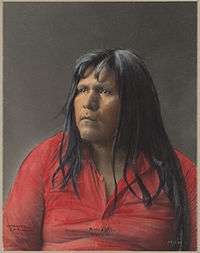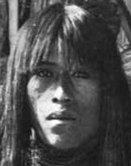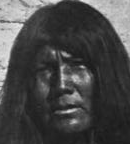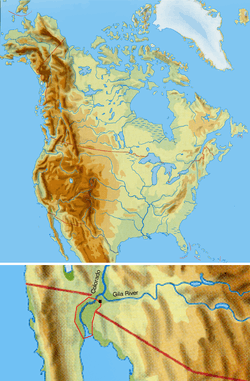Cocopah
The Cocopah, also Cucapá (in Cocopa: Kwapa or Kwii Capáy - "Cloud People" referring to the fog along the Colorado River), are Native Americans who live in Baja California and Sonora, Mexico, and in Arizona in the United States.
 Middle Sky, Cocapah, photo by Frank A. Rinehart, 1899 | |
| Total population | |
|---|---|
| 1,009 in the United States (2010)[1] | |
| Regions with significant populations | |
( | |
| Languages | |
| Cocopah, English, Spanish | |
| Religion | |
| Traditional tribal religion | |
| Related ethnic groups | |
| other Yuman peoples |


The Cocopah language belongs to the Delta–California branch of the Yuman family. The Spanish term for Cocopah is Cucapá. Their self-designation is Xawiƚƚ kwñchawaay, translating to “Those Who Live on the Cloudy River” (from Xawíƚƚy - "river", kwii - "cloud", (ny)way - "to live", llyay/nyaam - "many"). According to the US Census, there were 1,009 Cocopah in 2010.[1]
History

Pre-Contact
Ancestors of the Cocopah inhabited parts of present-day Arizona, California, and Baja California and are known by western academics as belonging to the Patayan culture. Patayan is a term used by archaeologists to describe prehistoric Native American cultures who inhabited parts of modern-day Arizona, west to Lake Cahuilla in California, and in Baja California, between 700–1550 A.D. This included areas along the Gila River, Colorado River and in the Lower Colorado River Valley, the nearby uplands, and north to the vicinity of the Grand Canyon.They are mostly likely ancestors of the Cocopah and other Yuman-speaking tribes in the region. The Patayan peoples practiced floodplain agriculture where possible and relied heavily on hunting and gathering.
Post Contact
The first significant contact of the Cocopah with Europeans and Africans probably occurred in 1540, when the Spanish explorer Hernando de Alarcón sailed into the Colorado River delta. The Cocopah were specifically mentioned by name by the expedition of Juan de Oñate in 1605.
Cocopah Tribe of Arizona
Cocopah peoples in the United States are enrolled in the Cocopah Tribe of Arizona. As of the 2000 United States Census, the Cocopah Tribe of Arizona numbered 891 people.[1] There is a casino, speedway, resort, family entertainment center and bingo hall on the reservation as well as a Museum and Cultural Center. Another Yuman group, the Quechan, lives in the adjacent Fort Yuma Indian Reservation. On important occasions, Cocopah people wear their customary ribbon shirts and ribbon dresses.
Notable Cocopah people
- Frank Tehanna, A Cocopah capitan who helped gain United States recognition and tribal lands for the Cocopah Indian Tribe near Somerton, Arizona in 1917.
- Bravie Soto, A US Army Sergeant who served with Recon Platoon, Echo, 2/39, 9 Infantry Division. He is often reported by family members and tribal historians to be the first Native American Casualty in the Vietnam War[2]
Notes
- U.S. Census Bureau, Census 2010 Census 2010 American Indian and Alaska Native Summary File (AIANSF) - Sample Data, Cocopah Tribe of Arizona alone or in Combination, M22
- "Bravie Soto", Wall of Faces.
References
- Pritzker, Barry M. A Native American Encyclopedia: History, Culture, and Peoples. Oxford: Oxford University Press, 2000. ISBN 978-0-19-513877-1.
Further reading
- Gifford, E.W. (1933). The Cocopa. University of California Publications in American Archaeology and Ethnology, Vol 35:5, Pg 257–334.
- Kelly, William H. (1977). Cocopa Ethnography. Anthropological papers of the University of Arizona (No. 29). Tucson: University of Arizona Press. ISBN 0-8165-0496-2.
| Wikimedia Commons has media related to Cocopah. |
External links
- Cocopah Indian Tribe, official website